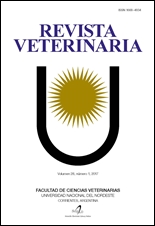Evaluation of herbicide glyphosate effects in the fish Prochilodus lineatus using chromosome aberration test
DOI:
https://doi.org/10.30972/vet.2811555Keywords:
fish, glyphosate exposure, chromosome aberrations, mutagenesis.Abstract
The widespread use of glyphosate has been subject of numerous controversies since the prolonged exposure to low concentrations of this substance could lead to toxic effects. Then, the appearance of pathologies in medium and long term progressively will increase because of the exposure of people and animals through the consumption of contaminated water or food. Considering this, the aim of this study was to evaluate the potential mutagenicity of glyphosate herbicide in fish (Prochilodus lineatus) using the test of chromosome aberrations. The fish were exposed to 0,1 ug/l of glyphosate for 70 days. After this period, samples of the anterior portion of the kidney were extracted for chromosomal aberrations (CAs) analysis. A greater number of CAs (gaps, breaks, stickiness, endomitosis, fragmentations, and pulverizations) were observed in individuals exposed to the pesticide. The statistical analysis of the data showed significant differences between the control and treated groups. In this way, the results suggested the existence of a genetic response as a consequence of pesticide exposure in fish.Downloads
Downloads
Published
How to Cite
Issue
Section
License
Copyright (c) 2017 C. S. Caramello, M. J. Jorge, N. L. Jorge, L. C. Jorge

This work is licensed under a Creative Commons Attribution-NonCommercial 4.0 International License.
Revista Veterinaria (Rev. Vet.) maintains a commitment to the policies of Open Access to scientific information, as it considers that both scientific publications as well as research investigations funded by public resources should circulate freely without restrictions. Revista Veterinaria (Rev. Vet.) ratifies the Open Access model in which scientific publications are made freely available at no cost online.











.jpg)
.jpg)



